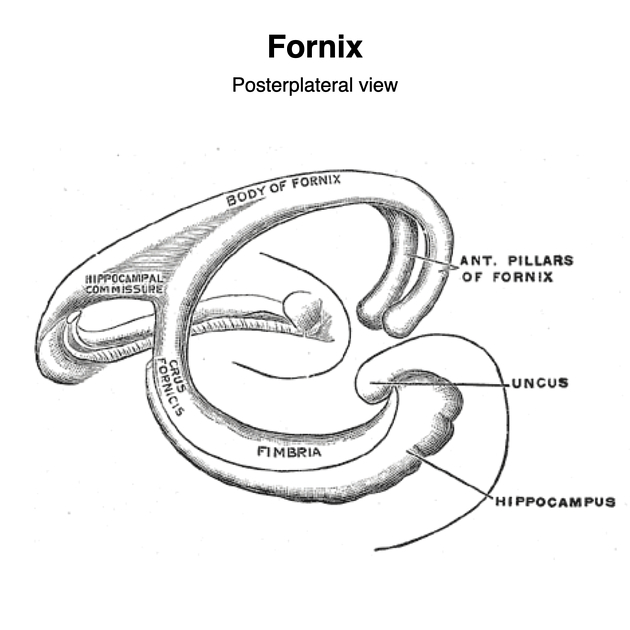The fornix (plural: fornices) is the main efferent system of the hippocampus and an important part of the limbic system. It is one of the commissural fibers connecting the cerebral hemispheres.
On this page:
Gross anatomy
Roughly C-shaped, the fornix extends from the hippocampus to the mammillary bodies of the hypothalamus and the anterior nuclei of the thalamus. It is a curvilinear bundle of white matter fibers that begins as a group of myelinated fibers called the alveus. The alveus joins to form the fimbria of the hippocampus. The fimbria of each hippocampus thickens and then splits off from the hippocampus to form the crus (leg) of the fornix.
The fornix is composed of four parts 1-5:
bilateral crura: ascending anterior to the splenium of the corpus callosum at the level of the superior colliculus (best seen on coronal images)
commissure: connecting the crura
body: from the merging of the crura, provides one of two major paths through which the hippocampi communicate with each other
bilateral columns (anterior pillars): curve anteroinferiorly and divide anterior and posterior to the anterior commissure into postcommissural and precommissural fiber tracts 5.
Fiber tracts
At the level of the anterior commissure, the columns divide into anterior and posterior fibers. The anterior fibers (called precommissural fibers) end in the septal region and nucleus accumbens, medial prefrontal cortex and septal nuclei 1,2,5. The posterior fibers (called the postcommissural fornix) project to the mammillary bodies. Small fibers are also sent to the anterior thalamus 5.
The fornix connects:
the hippocampus to the mammillary bodies
the hippocampus to the septal nuclei and the nuclei accumbens
the mammillary bodies to the anterior nuclei of the thalamus
Relations
superiorly: septum pellucidum anteriorly, splenium of corpus callosum posteriorly
inferiorly: thalamus anteriorly
medially: third ventricle (lies inferior to the body of the fornix)
laterally: medial aspects of the cerebral hemispheres
anteriorly: anterior commissure
posteriorly: posterior commissure, splenium of corpus callosum
Arterial supply
mainly from the short medial central arteries (derived from the proximal anterior cerebral artery) and/or the subcallosal artery (branch of the anterior communicating artery) 3,4
Related pathology
transection of the fornix: at the level of its body can lead to memory loss 1,2






 Unable to process the form. Check for errors and try again.
Unable to process the form. Check for errors and try again.